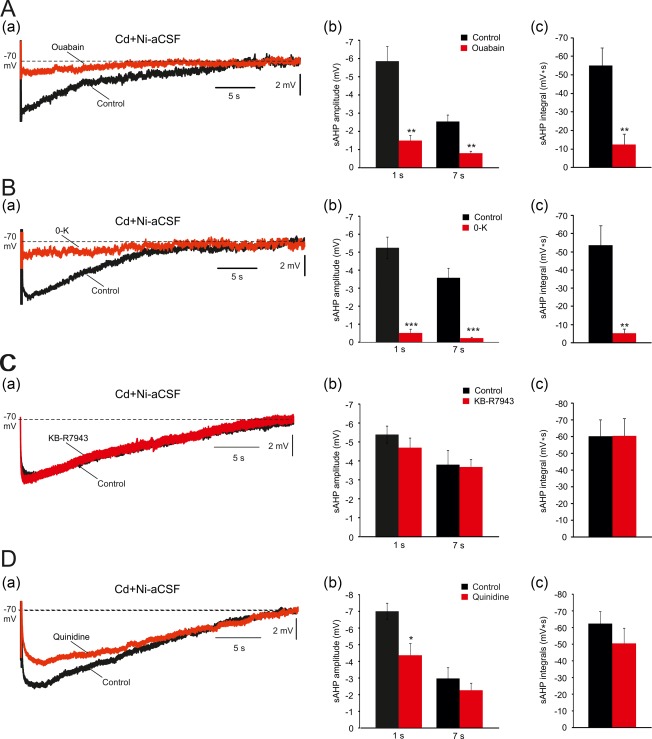Figure 5.

Effects of NKA and NCX inhibition on the Ca2+‐independent sAHP component. (A. a) In a representative neuron, sAHPs were evoked by 50 Hz spike trains of 150 spikes in Cd+Ni‐aCSF. Application of 10 μM ouabain markedly reduced the sAHPs (the traces depict the sAHPs before and 20 min after ouabain application, respectively). (b and c) Bar diagrams depicting the pooled results (mean ± SEM; n = 5) for sAHP amplitudes (measured at 1 and 7 s post‐stimulus) and integrals, respectively. (B. a) Same as in Aa, but NKA inhibition was attained by exchanging the standard Cd+Ni‐aCSF with K+‐free Cd+Ni‐aCSF (the traces depict the sAHPs before and 20 min after exchanging to K+‐free aCSF, respectively). (b and c) Bar diagrams depicting the pooled results (mean ± SEM; n = 5) for sAHP amplitudes (measured at 1 and 7 s post‐stimulus) and integrals, respectively. (C. a) Same as in Aa, but 10 μM KB‐R7943, a blocker of reversed Na+–Ca2+ transport, were added to the Cd+Ni‐aCSF (the traces depict the sAHPs before and 30 min after adding KB‐R7943, respectively). (b and c) Bar diagrams depicting the pooled results of 5 experiments (mean ± SEM; n = 5) for sAHP amplitudes (measured at 1 and 7 s post‐stimulus) and integrals, respectively. No significant change in the sAHP was imposed by this drug. (D. a) Same as in Aa, but 1 mM quinidine, a KNa channel blocker, was added to the Cd+Ni‐aCSF. Quinidine mildly reduced the sAHPs (the traces depict the sAHPs before and 30 min after adding quinidine, respectively). (b and c) Bar diagrams depicting the pooled results (mean ± SEM; n = 5) for sAHP amplitudes (measured at 1 and 7 s post‐stimulus) and integrals, respectively. The drug effect was significant only when measured at 1 s post‐stimulus amplitudes [Color figure can be viewed at http://wileyonlinelibrary.com]
